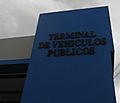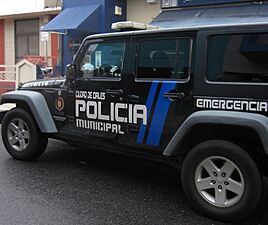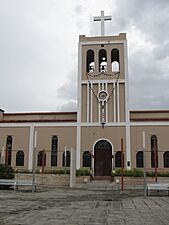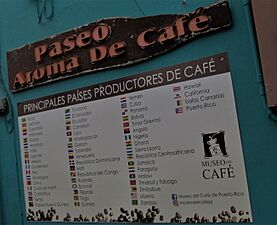Ciales, Puerto Rico facts for kids
Quick facts for kids
Ciales, Puerto Rico
Municipio de Ciales
|
|||
|---|---|---|---|
|
Town and Municipality
|
|||
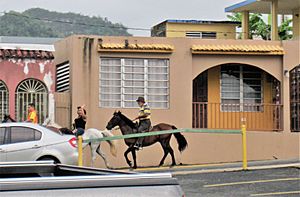
Horse-back riding in Ciales barrio-pueblo
|
|||
|
|||
| Nicknames:
See below
|
|||
| Anthem: "El cantar de tus ríos es mensaje" | |||

Map of Puerto Rico highlighting Ciales Municipality
|
|||
| Sovereign state | |||
| Commonwealth | |||
| Founded | June 24, 1820 | ||
| Founded by | Isidro Rodríguez | ||
| Barrios | |||
| Area | |||
| • Total | 66.48 sq mi (172.17 km2) | ||
| • Land | 66 sq mi (172 km2) | ||
| • Water | 0.07 sq mi (.17 km2) | ||
| Population
(2020)
|
|||
| • Total | 16,984 | ||
| • Rank | 65th in Puerto Rico | ||
| • Density | 255.494/sq mi (98.647/km2) | ||
| Demonym(s) | Cialeños | ||
| Time zone | UTC−4 (AST) | ||
| ZIP Code |
00638
|
||
| Area code(s) | 787/939 | ||
| Major routes | |||
Ciales (Spanish pronunciation: [ˈsjales], locally [ˈsjaleʔ]) is a town and municipality of Puerto Rico, located on the Central Mountain Range, northwest of Orocovis; south of Florida and Manatí; east of Utuado and Jayuya; and west of Morovis. Ciales is spread over eight barrios and Ciales Pueblo (the downtown area and the administrative center of the city). It is part of the San Juan-Caguas-Guaynabo Metropolitan Statistical Area.
Contents
Toponym
Sources diverge on the origin of the Ciales name. Nineteenth-century historian Cayetano Coll y Toste stated that it was named as such by then-governor Gonzalo de Aróstegui Herrera in honor of General Luis de Lacy, who had gone against Ferdinand VII's absolutist wishes. Coll y Toste suggested that the Villa Lacy name came from the anagram "es-la-cy" anagram.
Other sources, such as Manuel Álvarez Nazario and Luis Hernández Aquino, put forward the theory that it comes from the plural of cibales, plural form of ciba, meaning "stony place" or "place of stones" in Taíno, which "had undergone loss of the intervocalic -b- and the addition of the Spanish suffix referring to place -al." Lisa Cathleen Green-Douglass, who carried out a study of toponymics in Puerto Rico and compared both theories, believed the latter to be most plausible since Coll y Toste, per Green-Douglass, must have defined an anagram as a reversal of syllables and the resulting "Cial" or "Cyal" would have to then be made plural.
Yet others believe it originates from the Spanish sillar (meaning "carved stones") in reference to the stones carved by the Río Grande de Manatí's currents.
History
Ciales was founded on June 24, 1820 by Isidro Rodríguez.
Geography
- Toro Negro Forest Reserve
- Rivers are: Río Cialitos, Río Grande de Manatí, Río Toro Negro, and Río Yunes.
- Zip Code 00638
Demographics
| Historical population | |||
|---|---|---|---|
| Census | Pop. | %± | |
| 1900 | 18,115 | — | |
| 1910 | 18,398 | 1.6% | |
| 1920 | 20,730 | 12.7% | |
| 1930 | 20,492 | −1.1% | |
| 1940 | 22,906 | 11.8% | |
| 1950 | 19,464 | −15.0% | |
| 1960 | 18,106 | −7.0% | |
| 1970 | 15,595 | −13.9% | |
| 1980 | 16,211 | 3.9% | |
| 1990 | 18,084 | 11.6% | |
| 2000 | 19,811 | 9.5% | |
| 2010 | 18,782 | −5.2% | |
| 2020 | 16,984 | −9.6% | |
| U.S. Decennial Census 1899 (shown as 1900) 1910-1930 1930-1950 1960-2000 2010 2020 |
|||
Ciales has one of the lowest percentages of English speakers in Puerto Rico.
When researching the town's parochial baptismal records historian Fernando Picó found that more than half the offspring baptised at the end of the nineteenth century were born out of wedlock.
Tourism
To stimulate local tourism, the Puerto Rico Tourism Company launched the Voy Turistiendo ("I'm Touring") campaign, with a passport book and website. The Ciales page lists Museo Juan Antonio Corretjer, Puente Mata de Plátano, and Cascada Las Delicias, as places of interest.
Landmarks and places of interest
Places of interest in Ciales include:
- Artesanía en Muebles La Cialeña, family-owned factory that produces widely recognized enea grass-weaved furniture
- Aserrado Fernando Otero, located in Hato Viejo, it is the largest sawmill in Puerto Rico of native woods.
- Hacienda Carvajal, environmental education coffee and cacao farm that also houses a printing museum and a batey.
- Hacienda Negrón
- Las Archillas Cave
- Las Golondrinas Cave
- Yuyú Cave
- Parada Choferil
- Toro Negro Forest Reserve
- Paseo Lineal Juan Antonio Corretjer, a lookout
- Museo Biblioteca Casa Corretjer, houses the library of Juan Antonio Corretjer.
- Museo del Café, a coffee museum
Culture
Festivals and events
Ciales celebrates its patron saint festival in October. The Fiestas Patronales de Nuestra Señora del Rosario y San Jose is a religious and cultural celebration that generally features parades, games, artisans, amusement rides, regional food, and live entertainment. The festival has featured live performances by well-known artists such as Sabor Latino.
Other festivals and events celebrated in Ciales include:
- Three King's Day, held in January
- Corretjer Cantata, held in March
- Fresh Water Festival (in Spanish: Festival de Agua Dulce), mud bogging competition and music festival held in August
- Frontón Festival, held in July
- Saint Elías Festival, held in July
Sports
Ciales is the home town of Juan "Pachín" Vicens - Puerto Rico's national basketball star, named Best Player in the World at the 1959 World Basketball Championship, Santiago de Chile (a.k.a., Juan "Pachín" Vicens, "Astro del Balón", "El Jeep"; younger brother of Puerto Rico's National Poet, Nimia Vicens, who also hailed from Ciales). Their middle brother, Enrique "Coco" Vicens, a former Puerto Rico Senator, was a track and field athlete in his own right.
Economy
Agriculture
The Ciales economy has always depended heavily on agriculture, especially coffee products, minor fruits (such as lettuce) and dairy production.
Symbols
The municipio has an official flag and coat of arms. On the 150th anniversary of the founding of Ciales, the flag and coat of arms were adopted with Resolution No. 13 Series 1969–1970, sanctioned by Don Ismael Nazario, who was mayor at the time.
Flag
The flag is divided into seven unequal stripes described in sequence: yellow, red, yellow, purple, yellow, red, and yellow.
Coat of arms
The coat of arms consists of a gold shield with a lion standing on its rear legs and silverplated nails grasping a silver coiled parchment between its front claws. The lion also shows a red tongue. Above the lion in the superior part of the shield are located three heraldic roses arranged horizontally with red petals and green leaves. A golden crown of three towers rests on the shield. The three towers are united by walls, simulating masonry blocks. The shield is surrounded by a crown of coffee tree branches with their berries, all in natural colors.
Nicknames
- Town of the Brave (Pueblo de los valerosos) for the high concentration of independence supports, such as Juan Antonio Corretjer, some of which participated in the Grito de Lares.
- Cradle of Poets (Cuna de poetas) due to it being the birthplace of several poets, such as Juan Antonio Corretjer and Nimia Vicéns, both considered Puerto Rico's national poets.
- Central Cordillera Gate (Puerta de la Cordillera Central) owing to its geographic location on the Cordillera Central mountainous range.
- Switzerland of Puerto Rico (Suiza de Puerto Rico) on account of "its similarity to European valleys with abundant vegetation," and the wooden houses that are located in them.
Transportation
There is a public transportation terminal in downtown Ciales. In addition, there are 18 bridges in Ciales, including the NRHP-listed Manatí Bridge at Mata de Plátano.
Notable people from Ciales
- Armando Carlo Asencio Rosado-barril de bomba artisan.
- Edwin Avilés - singer and part of the Los Pleneros de la Cresta quintet.
- Ramón Barrios - Socialist Party delegate to the Constitutional Convention of Puerto Rico.
- Juan Antonio Corretjer - Nationalist and poet, considered the National Poet of Puerto Rico.
- Ángel de Jesús Sánchez - fifth Chief Justice of the Supreme Court of Puerto Rico.
- Raúl Feliciano - basketball player and lawyer.
- Ed Figueroa - MLB Baseball Player
- Juan Figueroa - Former-president of Universal Health Care Foundation of Connecticut.
- Antonio J. González - Puerto Rico Independence Party founder and gubernatorial candidate, Puerto Rican Union Party gubernatorial candidate, and UPRRP College of Social Sciences dean.
- Jovino González Rodríguez - seven-time National Troubadour.
- José Emilio González Velázquez - Politician
- Luis Maldonado - Politician
- Ángel Chayanne Martínez - Politician
- Luis Molina Casanova - Film director and scriptwriter.
- Jorge Luis Morales - Poet and writer
- Jeyluix Ocasio - singer and part of the Los Pleneros de la Cresta quintet, brother of Joshua and Joseph Ocasio.
- Joshua Ocasio - singer and part of the Los Pleneros de la Cresta quintet, brother of Jeyluix and Joseph Ocasio.
- Joseph Ocasio - singer and part of the Los Pleneros de la Cresta quintet, brother of Joshua and Jeyluix Ocasio.
- Mercedes Otero - Politician
- Jorge L. Porras Cruz - Educator and writer, Hispanic Studies department chair at the University of Puerto Rico, Río Piedras campus
- Edwin Reyes - Poet and writer
- José L. Rivera - USMC, recipient of the Navy Cross
- Gabriel Rodríguez Aguiló - Politician
- Juan José Rodríguez Pérez - Politician
- Hiram Rosado - Nationalist
- Carlos Manuel Rosario - Activist
- Luis Sánchez Morales - Politician
- Adalberto Santiago - Salsa singer, Tony Vega's cousin.
- Arturito Santiago Labrador - singer and restaurateur, highly recognized in the jíbaro music scene.
- Arturo Santiago Guzmán - four-time National Troubadour, son of Arturito Santiago Labrador.
- Lisvette M. Sanz González - singer and guitar player, part of the Hermanos Sanz duo.
- Luis Sanz González - singer and cuatro player, part of the Hermanos Sanz duo.
- Tony Vega - salsa singer, Adalberto Santiago's cousin.
- Vanessa Vélez - Volleyball player.
- Enrique "Coco" Vicéns - Basketball Player
- Juan "Pachín" Vicéns - Basketball Player
- Nimia Vicéns - poet, proclaimed Puerto Rico's national poet by Pedro Albizu Campos.
Gallery
See also
 In Spanish: Ciales para niños
In Spanish: Ciales para niños






